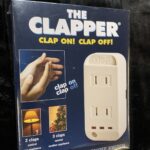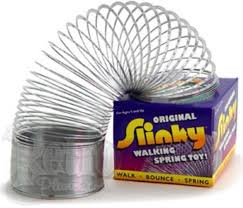 Among the countless gadgets that found their way into homes during the 1980s, few were as unforgettable—or as gleefully kitschy—as The Clapper. Sold through relentlessly catchy television commercials that etched themselves into pop culture with the phrase “Clap on! Clap off! The Clapper!”, this sound-activated device promised the kind of futuristic convenience that fit perfectly in a decade obsessed with technology, remote controls, and home automation. At a time when VCRs still blinked “12:00” and rotary phones still rang in kitchens, The Clapper was a beacon of progress—a gadget that let you control your lights with nothing more than the sound of your hands.
Among the countless gadgets that found their way into homes during the 1980s, few were as unforgettable—or as gleefully kitschy—as The Clapper. Sold through relentlessly catchy television commercials that etched themselves into pop culture with the phrase “Clap on! Clap off! The Clapper!”, this sound-activated device promised the kind of futuristic convenience that fit perfectly in a decade obsessed with technology, remote controls, and home automation. At a time when VCRs still blinked “12:00” and rotary phones still rang in kitchens, The Clapper was a beacon of progress—a gadget that let you control your lights with nothing more than the sound of your hands.
The Clapper first appeared in the late 1980s and was sold by Joseph Enterprises, the same company that brought the world the Chia Pet. Much like the Chia, The Clapper was a low-tech invention that gained massive popularity thanks to clever marketing and the unique sensibility of the time. It wasn’t just about functionality—it was about novelty. This was the beginning of a cultural shift where homes were slowly starting to feel “smart,” and The Clapper was a primitive but charming step in that direction.
At its core, The Clapper was a simple sound-activated electrical switch. You’d plug a lamp, TV, or other small appliance into the unit, then plug The Clapper into a wall socket. Once set up, it would “listen” for two distinct hand claps. Hear the claps, and the device would toggle the power on or off. Some versions had additional settings, such as turning on one appliance with two claps and another with three. In an age before voice assistants and smart plugs, this felt like magic. You could lie in bed and turn off the lights without getting up. You could walk into a room and power on your fan with a dramatic round of applause. It was fun, quirky, and just futuristic enough to capture the public’s imagination.
The real genius behind The Clapper’s success wasn’t its technology—it was its advertising. The TV commercials were unforgettable. Usually broadcast during late-night slots or sandwiched between reruns of old sitcoms, the ads featured a variety of people clapping their hands in domestic settings: a woman in bed clapping off her lamp, an older man clapping his TV to life, all set to the sing-song jingle: “Clap on (clap clap), Clap off (clap clap), The Clapper!” It was catchy, it was goofy, and it worked. Within a few seconds, even a half-asleep viewer knew what the product was and how it functioned.
The commercials also knew how to appeal to a wide audience. They presented The Clapper as a tool for convenience, yes, but also for accessibility. Elderly users and those with limited mobility were often shown in the ads, demonstrating how the device could help them manage lights and appliances without having to get up or reach difficult switches. This gave The Clapper an unexpected layer of usefulness that went beyond its novelty appeal. For many people with disabilities or physical limitations, The Clapper offered a bit more independence and control in their daily lives.
Despite its simple mechanism, The Clapper wasn’t without its quirks. The sound sensors could sometimes be a little too sensitive—or not sensitive enough. A dog barking, a dropped object, or the slamming of a door could accidentally trigger the device, plunging a room into darkness or powering on a TV unexpectedly. Likewise, some users complained that clapping too softly didn’t register, while clapping too quickly confused the unit. But these flaws often became part of the product’s charm. It was a gadget that demanded its own rhythm, and when it worked, it felt like a mini-miracle.
The Clapper became an unexpected pop culture punchline, showing up in parodies, sitcoms, and even stand-up routines. Comedians poked fun at its over-the-top ads and the absurdity of shouting or clapping to control your appliances. Saturday Night Live and other sketch shows would spoof the commercials, sometimes imagining ridiculous variations like The Yeller or The Snapper. But even when it was the butt of a joke, The Clapper was always recognizable—and that level of brand awareness is something most products only dream of.
As home technology began to evolve in the 1990s and 2000s, The Clapper gradually started to feel dated. New innovations like infrared remotes, motion sensors, and eventually Wi-Fi-enabled smart devices offered more precise and versatile control over household electronics. Still, The Clapper remained in production and even received periodic updates. Some newer versions included sound sensitivity dials, surge protection, and multiple outlets. Yet the core concept—clap to control—remained unchanged, a testament to the enduring simplicity of the original idea.
Part of The Clapper’s appeal, even decades after its heyday, is how thoroughly it captured the spirit of its time. The 1980s were obsessed with convenience gadgets: electric can openers, bread machines, answering machines, and cordless phones filled the modern American home. The Clapper fit neatly into this ecosystem. It didn’t try to change the world—it just offered a tiny slice of futuristic living in a compact, affordable package.
Today, The Clapper is as much a nostalgic relic as it is a functioning product. It occupies a special place in the collective memory of Gen Xers and older Millennials, who remember it not just as a device, but as a television phenomenon. The commercial’s jingle is instantly recognizable, and the idea of clapping to turn off a lamp remains both amusing and endearing. It’s a product that, like many things from the ’80s, somehow straddles the line between clever and kitschy.
While the modern world has embraced voice-controlled smart home systems like Alexa, Google Home, and Siri, there’s still something charmingly satisfying about the tactile ritual of The Clapper. In an era of hyper-connectivity and silent touchscreens, a good old-fashioned double clap feels almost rebellious. It’s analog convenience at its most earnest—a quirky, low-tech ancestor to the smart homes we live in today.
Whether you view it as a goofy commercial relic or a genuinely helpful tool, The Clapper remains one of the most iconic gadgets of the 1980s. It proved that sometimes the simplest ideas, when packaged with a catchy jingle and a little bit of charm, could light up not just a room—but an entire generation.


